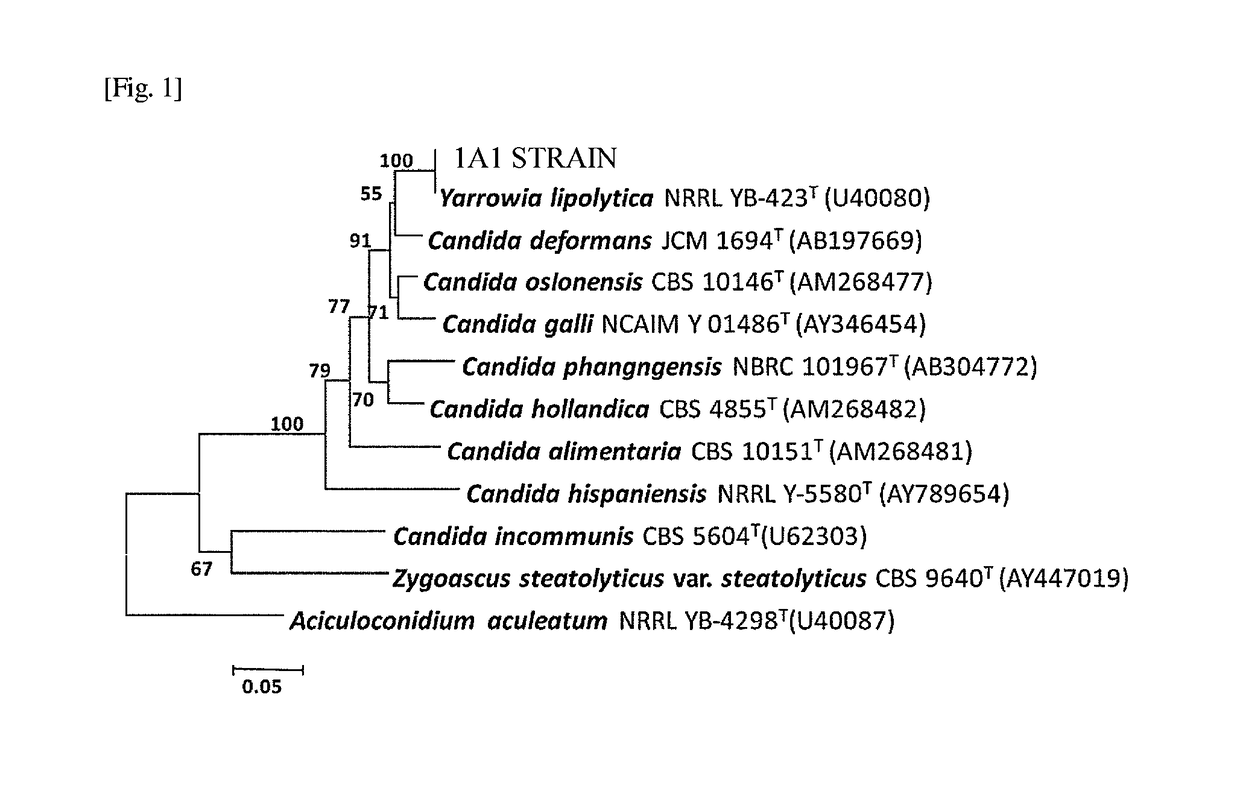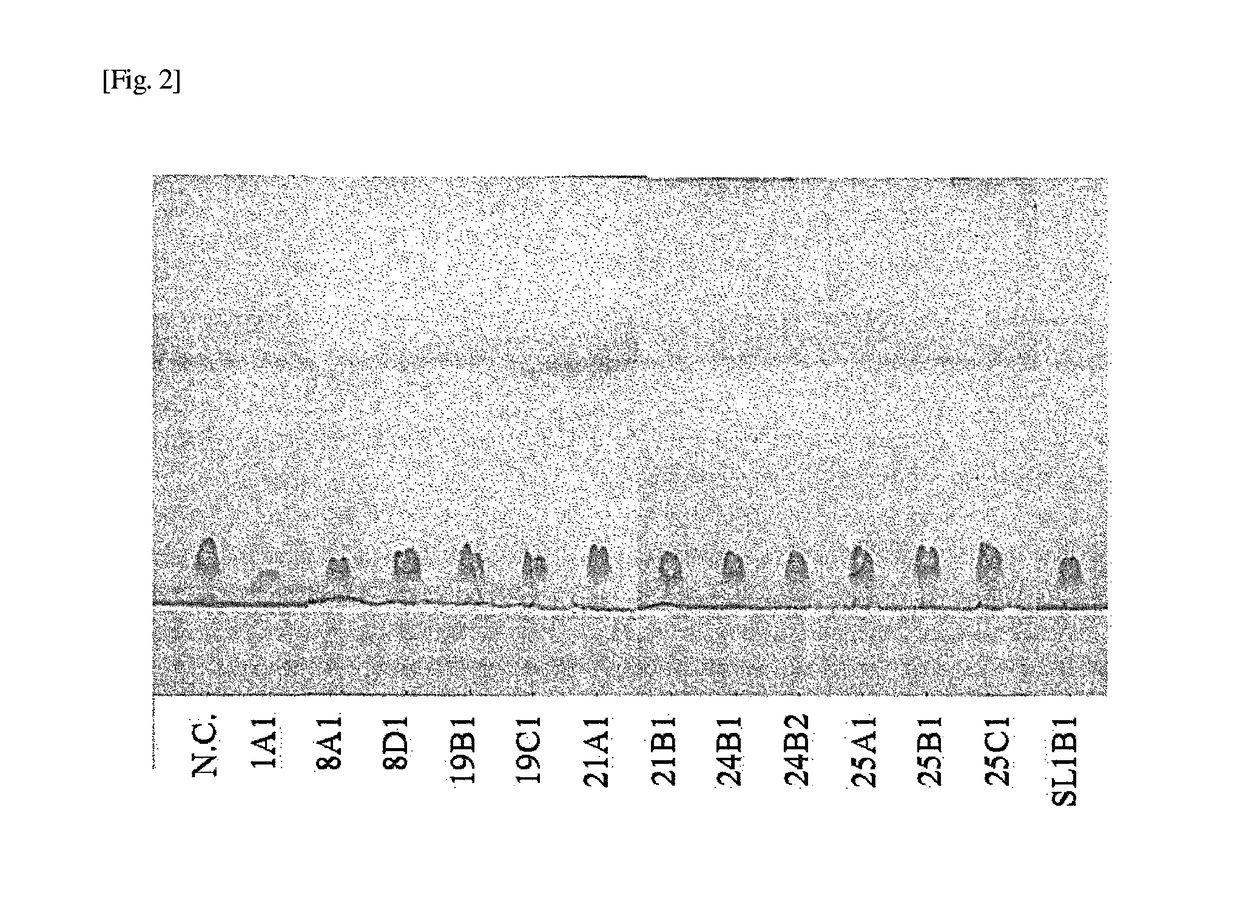Microorganism belonging to Yarrowia genus, and oil decomposition agent and oil decomposition/removal method using same
a technology of yarrowia and microorganisms, which is applied in the field of can solve the problems of difficult to treat an oil in only a grease trap, achieve the effects of improving the efficiency of oil and fat decomposition, promoting the decomposition of oils and fats, and high ability of triacylglycerol hydrolysis
- Summary
- Abstract
- Description
- Claims
- Application Information
AI Technical Summary
Benefits of technology
Problems solved by technology
Method used
Image
Examples
examples
1. Screening of Bacteria that Decompose and Assimilate Fatty Acids
[0074]In order to select microorganisms specialized for decomposition of fatty acids, 29 kinds of environment samples in total such as a grease in a grease trap tank, soil, sludge and lake water were obtained, and each sample was applied onto an agar culture medium containing oleic acid as a sole carbon source, and the formed single colony was collected and inoculated on the same culture medium; these operations were repeatedly conducted, whereby 12 strains of microorganisms that decompose and assimilate a fatty acid in total were successfully obtained. These 12 strains of microorganisms were each added to an inorganic salt liquid culture medium containing oleic acid as a sole carbon source, cultured under shaking at 28° C. for 24 hours, and compared for the growth of the microorganisms and the ability of decomposing oleic acid. Furthermore, the lipase secretion ability was evaluated by using an inorganic salt agar cu...
experiment 1
5. Oil and Fat Decomposition Experiment 1
[0079]10 g / L of canola oil was added to 3 L of an inorganic salt culture medium, and pure culturing of B. arboris SL1B1 strain or mix culturing of B. arboris SL1B1 and Y. lipolytica 1A1 strain was conducted at pH 6.0 and a temperature of 28° C. in a fermenter, and the decomposition behavior of the oil was analyzed. Sampling was conducted every 6 hours, and the fatty acid concentration and microorganism concentration were examined. The microorganism concentration was determined by colony counting on a LB culture medium, and the fatty acid was analyzed quantitatively by gas chromatography and qualitatively by thin layer chromatography. As a result, 10 g / L of triacylglycerol completely decomposed and disappeared within 30 hours in either of the pure culturing and mix culturing (FIG. 4). In the pure culture, the cell concentration of B. arboris reached 1010 cells / mL. In the mixed culture, both B. arboris and Y. lipolytica 1A1 strain reached 107-1...
experiment 2
6. Oil and Fat Decomposition Experiment 2
[0080]10 g / L of canola oil was added to 3 L of an inorganic salt culture medium, and pure culturing of B. arboris SL1B1 strain or mix culturing with Y. lipolytica 1A1 strain was conducted at pH 6.0 and a temperature of 22° C. by using a fermenter, and the decomposition behavior of the oil was analyzed. Sampling was conducted every 6 hour, and the fatty acid concentration and microorganism concentration were examined. The analysis method was similar to that of Experiment 5. As a result, it took 42 hours or more for the complete decomposition and disappearance of triacylglycerol in the pure culturing of B. arboris, whereas the hydrolysis velocity of the triacylglycerol and the consumption velocity of fatty acids were accelerated in the mix culturing, and triacylglycerol and fatty acids from 10 g / L of canola oil, almost decomposed and disappeared within 30 hours (FIG. 5). Furthermore, the bacterial density of B. arboris reached 108 cells / mL in t...
PUM
 Login to View More
Login to View More Abstract
Description
Claims
Application Information
 Login to View More
Login to View More - R&D
- Intellectual Property
- Life Sciences
- Materials
- Tech Scout
- Unparalleled Data Quality
- Higher Quality Content
- 60% Fewer Hallucinations
Browse by: Latest US Patents, China's latest patents, Technical Efficacy Thesaurus, Application Domain, Technology Topic, Popular Technical Reports.
© 2025 PatSnap. All rights reserved.Legal|Privacy policy|Modern Slavery Act Transparency Statement|Sitemap|About US| Contact US: help@patsnap.com



